Unlock Cross-Language Collaboration via AI Notes

Picture this: A product launch meeting with team members dialing in from Tokyo, Berlin, and São Paulo. The discussion grows animated as engineers debate technical specifications, but half the participants struggle to follow the rapid-fire English peppered with industry jargon. Someone volunteers to take notes, but their summary captures only fragments of what non-native speakers contributed. Critical insights get lost in translation, decisions stall, and follow-up emails spawn confusion rather than clarity. This scenario plays out thousands of times daily across global organizations, where language barriers transform collaboration into an exhausting game of telephone. Research shows multilingual teams waste up to 30% of meeting time on clarification and miscommunication alone. The cost extends beyond productivity—when team members can’t fully participate in their native language, companies lose diverse perspectives and innovative ideas. AI-powered note-taking systems are fundamentally changing this reality by automatically transcribing conversations in dozens of languages, translating content in real-time, generating clear summaries, and creating shared workspaces where every participant collaborates as equals regardless of their native tongue.
The Multilingual Meeting Crisis: Why Traditional Notes Fail Global Teams
When a German engineer’s breakthrough idea gets reduced to “technical suggestion” in meeting minutes, or a Japanese client’s concerns disappear entirely because the note-taker couldn’t parse accented English, organizations pay a steep price. A 2023 study by the Global Business Communication Institute found that companies with multilingual teams lose an average of 12 hours per employee monthly to language-related miscommunication—equivalent to $3,200 in wasted salary per person annually. Traditional note-taking compounds these problems. Human transcribers inevitably favor native speakers, capturing their contributions verbatim while paraphrasing or omitting non-native speakers’ input. Manual translation introduces delays of hours or days, rendering notes useless for time-sensitive decisions. Even well-intentioned bilingual team members struggle to simultaneously listen, translate mentally, and document accurately, producing incomplete records that benefit no one. This fragmentation creates security vulnerabilities as teams resort to unauthorized translation apps or forward sensitive content to external linguists. Perhaps most damaging is the psychological toll: non-native speakers gradually disengage when they realize their contributions won’t be accurately recorded, robbing organizations of diverse perspectives precisely when global markets demand them most.

Core AI Technologies Revolutionizing Meeting Notes
Multilingual Transcription: Speech-to-Text Beyond Borders
Modern AI transcription systems leverage deep learning models trained on millions of hours of speech data across 50+ languages, from Mandarin to Swahili. Unlike earlier voice recognition that required standardized pronunciation, today’s neural networks adapt to regional accents—distinguishing between Brazilian and European Portuguese, or recognizing Indian English alongside Australian variants. The technology works by converting audio waveforms into phonetic representations, then mapping these to text using language-specific models that understand grammar and context. Advanced error correction algorithms cross-reference uncertain words against meeting context, dramatically improving accuracy for technical terminology. These systems integrate directly with video conferencing platforms like Zoom, Microsoft Teams, and Google Meet, capturing audio streams without requiring separate recording equipment. The result is real-time transcription that maintains speaker identification even when participants switch between languages mid-sentence.

Automatic Translation Engines: Real-Time Understanding
Neural machine translation represents a quantum leap beyond simple word-for-word dictionary substitution. These AI systems analyze entire sentences to preserve meaning, idiomatic expressions, and tone—understanding that “break a leg” shouldn’t translate literally into other languages. The engines maintain context across paragraphs, recognizing when “bank” refers to financial institutions versus riverbanks based on surrounding discussion. Industry-specific models trained on technical documentation handle specialized vocabulary: medical AI distinguishes “discharge” in clinical versus electrical contexts, while legal translation preserves contractual precision. Integration happens at the transcription layer, where translation engines process text segments as they’re generated, delivering multilingual versions within seconds. This simultaneous processing enables participants to read meeting notes in their preferred language while discussion continues, eliminating the traditional lag between transcription and translation.
AI Summarizer: Distilling Cross-Language Knowledge
AI summarization employs two complementary approaches to condense multilingual transcripts. Extractive methods identify and pull the most significant sentences directly from conversations—highlighting key decisions, action items, and critical arguments regardless of which language they originated in. Abstractive summarization goes further, generating new sentences that capture essential meaning using natural language generation, much like a human would paraphrase. The AI recognizes argumentative structures across languages, distinguishing between a German speaker’s main proposal and supporting evidence, or identifying when a Japanese participant’s indirect phrasing actually signals disagreement. Advanced systems automatically extract action items with assigned owners, deadlines, and dependencies, tagging them for project management integration. Users customize summary length and focus—requesting executive overviews, detailed technical breakdowns, or decision-only logs—with the AI adapting output while preserving contributions from all language groups equally.

Language Collaboration Tools in Action: Feature Breakdown
Modern AI note systems create unified digital workspaces where multilingual transcripts exist as living documents rather than static files. Team members access the same meeting record simultaneously, with each person viewing content in their selected language—a French manager reads notes in French while her Korean colleague sees identical information in Korean, both versions updating in real-time as edits occur. Inline commenting functionality allows participants to ask clarifying questions or add context in their native language, with comments automatically translated for other readers. When a Spanish-speaking engineer highlights a technical specification and adds “¿Esto incluye compatibilidad con sistemas heredados?” the system instantly renders it as “Does this include legacy system compatibility?” for English readers. Version control tracks who made changes and when, maintaining audit trails across language variants to ensure accountability. Advanced search capabilities index content across all translated versions—a query for “budget constraints” retrieves relevant passages whether originally discussed in Japanese as “予算制約” or German as “Budgetbeschränkungen.” Granular access permissions let administrators restrict sensitive sections by department or language group, ensuring compliance with regional data regulations while maintaining collaborative transparency where appropriate. These integrated features transform notes from passive records into active collaboration hubs where language diversity becomes an asset rather than obstacle.
Implementation Roadmap: AI Notes for Global Teams
Step 1: Audit Existing Meeting Pain Points
Begin by surveying your team to identify which languages are actively used in meetings and documentation. Create a matrix showing language pairs that require frequent translation—perhaps your engineering team switches between English and Mandarin while sales operates in Spanish and Portuguese. Document specific communication failures from the past quarter: missed deadlines due to unclear action items, decisions that required re-explanation, or team members who stopped contributing. Evaluate your current technology stack for compatibility, checking whether your video conferencing platform offers API access for AI integration and whether your project management tools support automated task import. This audit reveals whether you need broad multilingual support or focused translation between two primary languages.
Step 2: Configuring Your Language Stack
Establish organizational defaults by setting primary and secondary languages based on your audit findings. Configure automatic language detection so the system recognizes when speakers switch languages mid-meeting without manual intervention. Customize translation preferences for technical terminology—upload glossaries of product names, proprietary terms, or industry jargon that shouldn’t be translated. Connect your AI note system to existing workflows by integrating with calendar applications to automatically schedule transcription for recurring meetings, and link to your CRM or project management platform so action items flow directly into task lists with proper language formatting for each assignee. Platforms like Owll AI offer integration capabilities that allow teams to connect ai note taking for meetings workflows with existing project management and communication tools, streamlining the transition from meeting discussions to actionable tasks.
Step 3: Deployment and Team Training
Launch with a pilot group representing diverse language backgrounds and meeting types—include both frequent and occasional participants to test different use cases. Develop onboarding materials in each primary language, creating short video tutorials that demonstrate core features like accessing translated transcripts and adding native-language comments. Establish a feedback channel where team members report translation errors or usability issues, assigning a multilingual coordinator to triage problems and communicate with your AI provider. Expand gradually to additional teams only after refining configurations based on pilot feedback, ensuring each new group receives language-appropriate training materials.
Step 4: Measuring Cross-Language Impact
Track quantitative metrics like average meeting duration before and after implementation, measuring whether real-time translation reduces time spent on clarification. Monitor decision velocity by calculating days between initial proposal and final approval for projects involving multilingual stakeholders. Survey participants monthly about comprehension levels, asking non-native speakers whether they understand action items more clearly and feel their contributions are accurately captured. Calculate time-to-consensus for cross-language discussions, comparing how quickly multilingual teams reach agreement on complex topics versus pre-AI baselines, providing concrete ROI data to justify continued investment.
Future-Proofing Collaboration: AI’s Evolving Role
The next generation of AI note systems will anticipate language needs before they arise, using predictive algorithms that suggest relevant translations based on meeting context and participant backgrounds. Emotion and sentiment analysis engines are learning to decode cultural communication styles—recognizing that a Japanese colleague’s silence may signal thoughtful agreement rather than confusion, or that a German team member’s direct phrasing reflects cultural norms rather than rudeness. These systems will provide real-time cultural coaching, alerting participants when their message might be misinterpreted across cultural boundaries. The convergence of AI notes with live interpretation technology promises seamless verbal translation during video calls, where participants speak their native language while others hear real-time translation through their headsets. Organizations will train custom AI models on their proprietary terminology and communication patterns, creating increasingly accurate systems that understand company-specific jargon and decision-making processes. However, these advances raise ethical questions about data privacy, algorithmic bias in translation quality across languages, and the potential erosion of language learning incentives. Forward-thinking companies are establishing governance frameworks now, ensuring their AI collaboration tools enhance human connection rather than replace the cultural intelligence that makes global teams truly innovative.
Transform Your Global Team Communication
AI-powered note-taking has transformed multilingual meetings from frustrating exercises in miscommunication into productive exchanges where every voice matters equally. By automatically transcribing conversations across dozens of languages, translating content in real-time, and generating clear summaries that preserve contributions from all participants, these systems eliminate the language silos that have long plagued global teams. The benefits extend far beyond saved time—organizations gain genuine inclusion where non-native speakers contribute confidently, decision-making accelerates when everyone understands action items clearly, and accuracy improves as critical details no longer disappear in translation gaps. In an increasingly interconnected business landscape, the ability to collaborate seamlessly across languages isn’t merely convenient—it’s a competitive necessity that separates agile global organizations from those still struggling with outdated communication methods. Start your transformation today by identifying your team’s primary language pairs and piloting an AI note system with a small multilingual group, measuring the impact on comprehension and decision velocity before expanding organization-wide.


